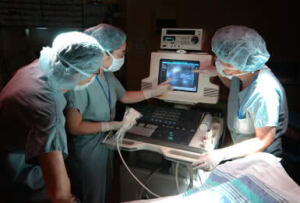JACR: Most ER docs use ultrasound
by
Brendon Nafziger, DOTmed News Associate Editor | September 12, 2011

Most emergency-room doctors at academic hospitals use point-of-care ultrasound, according to a recent survey. And having round-the-clock access to radiologists doesn't change that.
In the September issue of the Journal of the American College of Radiology, a small online survey of academic radiology departments found that 92 percent of academic centers had credentialed emergency room physicians perform bedside sonography work, such as sussing out internal bleeding or heart problems.
According to the study, prepared by Yale University doctors, the most commonly used studies were FAST (focused assessment with sonography for trauma), with 92 percent of respondents saying they were performed independently by ER doctors, cardiac echocardiography (54 percent), and pelvic ultrasound (51 percent).
Interestingly, not having round-the-clock access to radiologists did not explain the high use in the ER, according to the researchers.
True, fewer than a quarter of responding centers had 24/7 in-house attending radiologist coverage, with the rest getting coverage from attending radiologists during the day but residents at night. But the centers that did provide 24/7 coverage had no statistically significant difference in ER ultrasound activity: 89 percent of hospitals with uninterrupted access to radiologists had independent ER activity, as opposed to 93 percent of hospitals without such access.
Overall, the researchers said it was a "sensible approach" to have ER doctors use ultrasound for the diagnostic workup of ER patients in regions of the country where radiologists aren't available to perform ultrasound after hours. But they said the benefits were "less clear" at centers that provide round-the-clock, radiologist-provided ultrasound services.
"Although procedural and acute ultrasound studies are acceptable, the widespread adoption of diagnostic ultrasound studies by ER physicians might affect patient care if their efforts circumvent truly diagnostic, consultant-based examinations," wrote the authors, led by Dr. Thomas R. Goodman, with Yale. "Moreover, this practice may limit the exposure of radiology residents to acute ultrasound conditions. It also has the potential to cause confusion on the part of referring physicians when they are told by their patients that ultrasound was performed in the ER, but no record of it or its results exist in [diagnostic radiology]."
Nonetheless, the researchers pointed out some limitations in their study: it doesn't distinguish between credentialed studies, which doctors can act upon, and educational studies used to secure credentialing, which doctors can't act on. Also, it had a relatively low response rate (36 percent).
The survey, conducted between January and June 2010, went out to 111 members of the Society of Chairs of Academic Radiology Departments, and had 40 respondents.
|
|
|
You Must Be Logged In To Post A Comment
|
